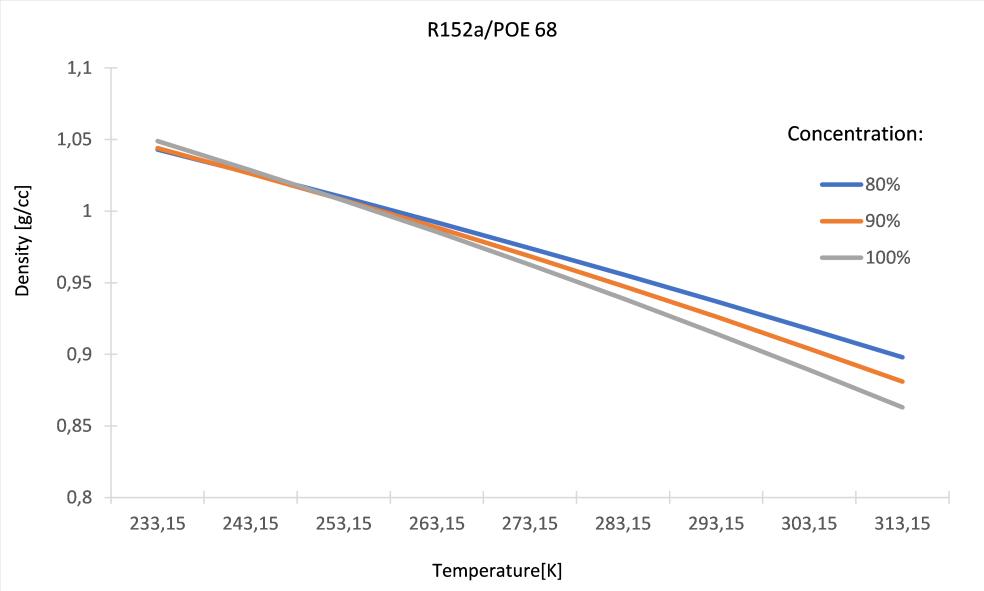
12 minute read
Investigation of the Thermodynamic Characteristics of the Ester Oil and R152a, R125, R134a and R123 Refrigerant Mixtures
Acta Universitatis Sapientiae Electrical and Mechanical Engineering, 13 (2021) 1424 DOI: 10.2478/auseme-2021-0002
Investigation of the Thermodynamic Characteristics of the Ester Oil and R152a, R125, R134a and R123 Refrigerant Mixtures
Advertisement
Robert Santa
University of Dunaújváros, Department of Mechanical Engineering, e-mail: santar@uniduna.hu
Manuscript received October 07, 2021; revised November 08, 2021.
Abstract: The presence of the lubricant POE 68 in the refrigeration system changes the thermophysical properties of the refrigerant, which significantly affects the heat transfer and the hydraulic processes. The purpose of this research is to investigate the thermodynamic properties of the R152a, R125, R134a and R123 refrigerant and POE 68 lubricant mixtures at different temperatures from 233,15 to 313,15 K. There have been investigated the values of the densities and kinematic viscosities of the mixtures at different concentrations (100%, 90%, 80%). Finally, it was found that, the density and kinematic viscosity of the R123/POE 68 mixture were most affected by the change of the concentration.
Keywords: Heat pump, refrigerant, oil, mixture, density, viscosity
1. Introduction
The modelling of the heat pumps is based on decades of experience as both of stationary [1], [2] and the non-stationary [3], [4] mathematical models. The mathematical models are fraught with a numerous omissions and uncertainties.
The accuracy of the heat pumps models is greatly affected by the accuracy of the pressure drop correlations which are used to determine the pressure drop of the refrigerant flowing in the tubes and the heat transfer correlations [5], [6] which are used to determine the heat transfer coefficients. In the literature, there are a large number of correlations of heat transfer and pressure drop, whose accuracy, validity is uncertain. Last, but not least, a considerable number of them ignore the effect of the oil in the refrigerant, although refrigerant oil is an essential requirement for the operation of the cycle. This study investigated the changes of the density and kinematic viscosity values of the refrigerant R152a,
Investigation of the Thermodynamic Characteristics of the Ester Oil 15
R125, R134a, R123 and the POE68 polyester oil mixtures as a function of the temperatures. The analysis was performed at high refrigerant concentrations in the mixture. The concentrations were 100%, 90% and 80 %, where 100 % represents the pure refrigerant.
2. Mathematical model 2d d u u u p g u t
p
Due to the complexity of the Navier-Stokes differential equations [7] used to g describe the flowing ref rigerant, it is extremely difficult to obtain an analytical solution. The form of the differential equation used here is:
2 u (1)
where the significance of the terms is the following: - pressure gradient (fluid flows in the direction of largest change in pressure);
- body force term (external forces, that act on the fluid);
- diffusion term (for a Newtonian fluid, viscosity operates as a diffusion of momentum).
However, in the equations, the resulting characteristic members can be related to each other as ratios, resulting ratios will be dimensionless expressions. The numerical values of the dimensionless expressions – similarity criteria – thus obtained are independent of the unit system used. In the formulation of hydrodynamic similarity criteria, the force of inertia is chosen as the reference basis.
The characteristic terms of the equation [1] can be primed, related to each other, using ratios. It is useful to turn the equation [1] into a dimensionless form. In order to formulate the hydrodynamic similarity criteria, the force of inertia is used as a reference value.
If all members are divided by this value, the result is the dimensionless criteria. The dimensional analysis method is also used to determine the amount of heat transferred during convective heat flow and the heat transfer coefficient.
In general, the heat transfer coefficient of the refrigerant can be determined as a function of the Reynolds number (Re), Prandtl number (Pr) and Grashof number (Gr): , (Re, Pr, Gr) f d
(2)
From the above equations it is clear that, in addition to the flow parameters, the characteristics of the refrigerant, i.e. the density and viscosity of the
16 R. Santa
refrigerant also play a decisive role. In order to analyze the heat pump cycle, it is necessary to determine the thermodynamic parameters of the function lubricant POE68 in order to be able to define thermal and hydraulic processes. The mathematical equations (3 - 10) are used to compute the kinematic viscosity and the density of the mixtures of 80%, 90% concentration solutions 2 2 2 2 1 2 3 4 2 6 7 8 9 r r r r r r a a T a T a a T a T a a T a T and of the pure 100% refrigerant. The equations are suitable for high refrigerant concentrations and temperatures between -40 °C and 40 °C. Algebraic equations are used for determining the density of the R134a/POE 68 polyester (pentaerythritol) Ester Mixed Acid and the R123/POE 68 pentaerythritol Ester Mixed Acid [8]: T 1 T
r CT
(3)
where, 2 3 5 6 8 9 1 4 72 2 2 a a a a a a a a T T T T T T
Kinematic viscosity is given by
100 1 2 3a a T a T
2 (4)
and is the refrigerant mass fraction.
The following algebraic equations a 2 re used for the determination of density and kinematic viscosity of the R125/POE 68 and the R152a/POE 68 pentaerythritol Ester Mixed Acid [8]:
90 4 5 6a a T a T 2 80 7 8 9a a T a T
log 3a 2 100 1 2 aa T T
log a 5 6 90 4 2 a a T T
(5)
(6)
(7)
log a 8 9 80 7 2 a a T T
(8)
(9)
(10)
Investigation of the Thermodynamic Characteristics of the Ester Oil 17
The coefficients are found in [8] and the subscript 100, 90, 80 refer to the mass fraction of the refrigerant.
3. Results and discussion
The figures below summarize the density and kinematic viscosity of the refrigerants R152a, R125, R134a and R123 and of the ester oil lubricant POE 68 as a function of the temperature.
Fig. 1 and Fig. 2 show the density and kinematic viscosity of a mixture of R152a refrigerant and POE68 oil. In the first figure it can be observed that below the limit of 273.13 K, influence of the concentration on the density, between 80% and 100% is practically insignificant. However, it can also be seen that as the temperature increases, the value of the density of the mixture also decreases considerably.
Figure 1: Density of the R152a/POE 68 as a function of the temperature
It can be noticed that at low temperatures 233.15 K and 80% concentration, the kinematic viscosity of the mixture increases significantly, while at higher temperatures 313.5 K, the difference in viscosity values presents less importance at different concentrations.
18 R. Santa
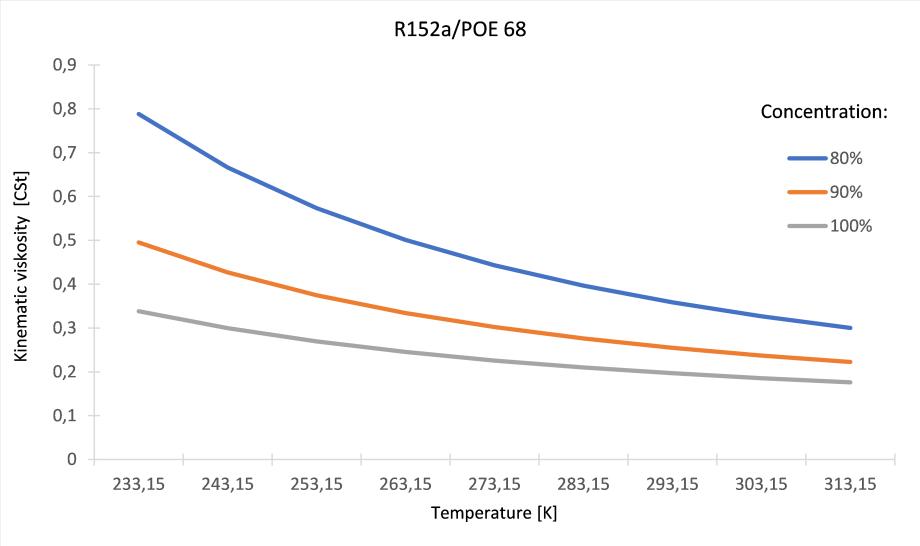
Figure 2: Kinematic viscosity of the R152a/POE 68 as a function of the temperature
The density and the kinematic viscosity of the mixture of R125 and POE68 can be seen in Figures 3 and 4.
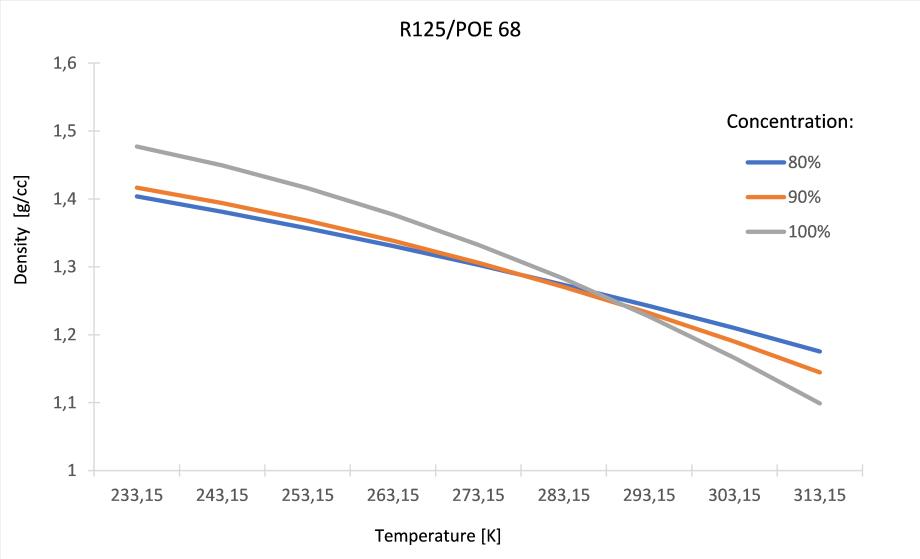
Figure 3: Density of the R125/POE 68 as a function of the temperature
Investigation of the Thermodynamic Characteristics of the Ester Oil 19
The figure shows that at 283.13 K the density of the mixture is nearly constant for all three concentrations at 80%, 90% and 100%. It can also be seen that as the temperature decreases, and at 100% concentration - pure refrigerant, the value of the refrigerant density is higher than at 80% and 90% concentration, while at a higher temperature of 313.15K the reverse of the phenomenon is observed.
Considering the kinematic viscosity, it is demonstrated that the viscosity value for a pure 100% refrigerant is nearly the same over the temperature range investigated, while for the 80% mixture the viscosity value increases significantly for low temperatures of 233.15 K.

Figure 4: Kinematic viscosity of the R125/POE 68 as a function of the temperature
The density and kinematic viscosity of the mixture of R134a and POE 68 are shown in Fig. 5 and Fig. 6. It can be seen that as the temperature decreases, the density value increases steadily for 80% and 90% concentration, but the highest density values are observed for the pure, i.e., 100% refrigerant.
20 R. Santa

Figure 5: Density of the R134a/POE 68 as a function of the temperature
Fig. 6 shows that at a low temperature of 233.15 K, the kinematic viscosity of a mixture with a concentration of 80% is five times greater than those of the pure refrigerant, whereas at higher temperatures 313.15 K it decreases to nearly the double.
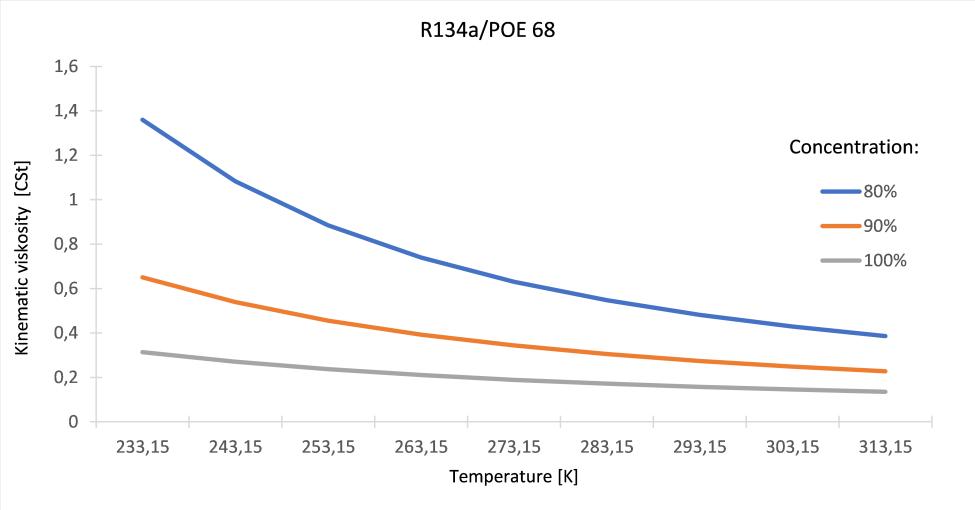
Figure 6: Kinematic viscosity of the R134a/POE 68 as a function of the temperature
Investigation of the Thermodynamic Characteristics of the Ester Oil 21
The density and kinematic viscosity of the refrigerant R123 and the lubricant POE 68 are summarized in Fig. 7 and Fig. 8. It can be deduced that as the temperature decreases, the density, and the kinematic viscosity values of all three mixtures increase and show the same trend as R134a/POE 68, but presenting larger numerical values, for both thermodynamic parameters.
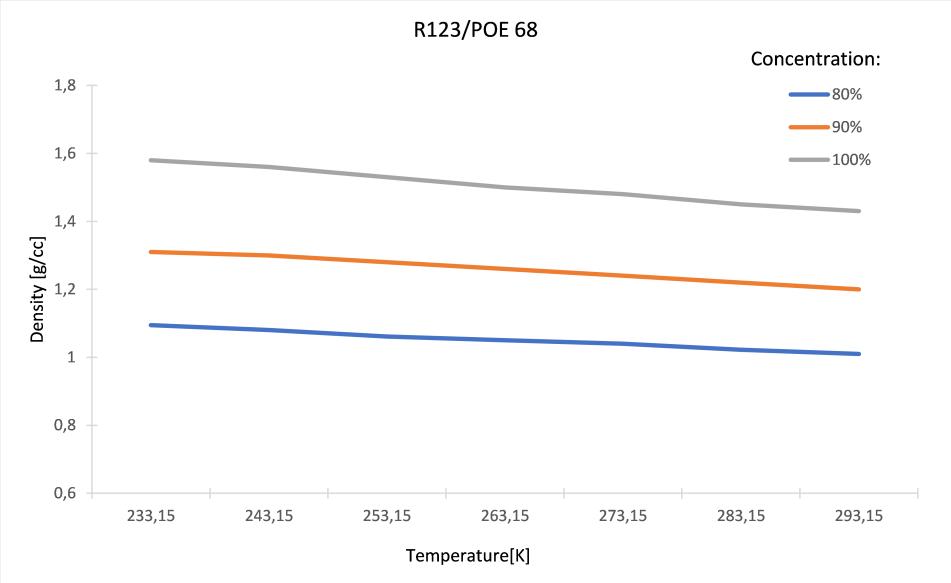
Figure 7: Density of the R123/POE 68 as a function of the temperature
Figure 8: Kinematic viscosity of the R123/POE 68 as a function of the temperature

22 R. Santa
The following figures show the effect of oil on the change of the heat transfer coefficient by way of a numeric simulation example. In the convective condensation heat transfer correlations [9], [10] the 80% and 90% mixture concentrations were taken into account.
The range of simulation conditions: Refrigerant: R134a; Vapor quality: 0.1 – 0.9 [-]; Mass flux: 125, 250 [kg/m2s]; Concentration: 80% 90%, 100%.
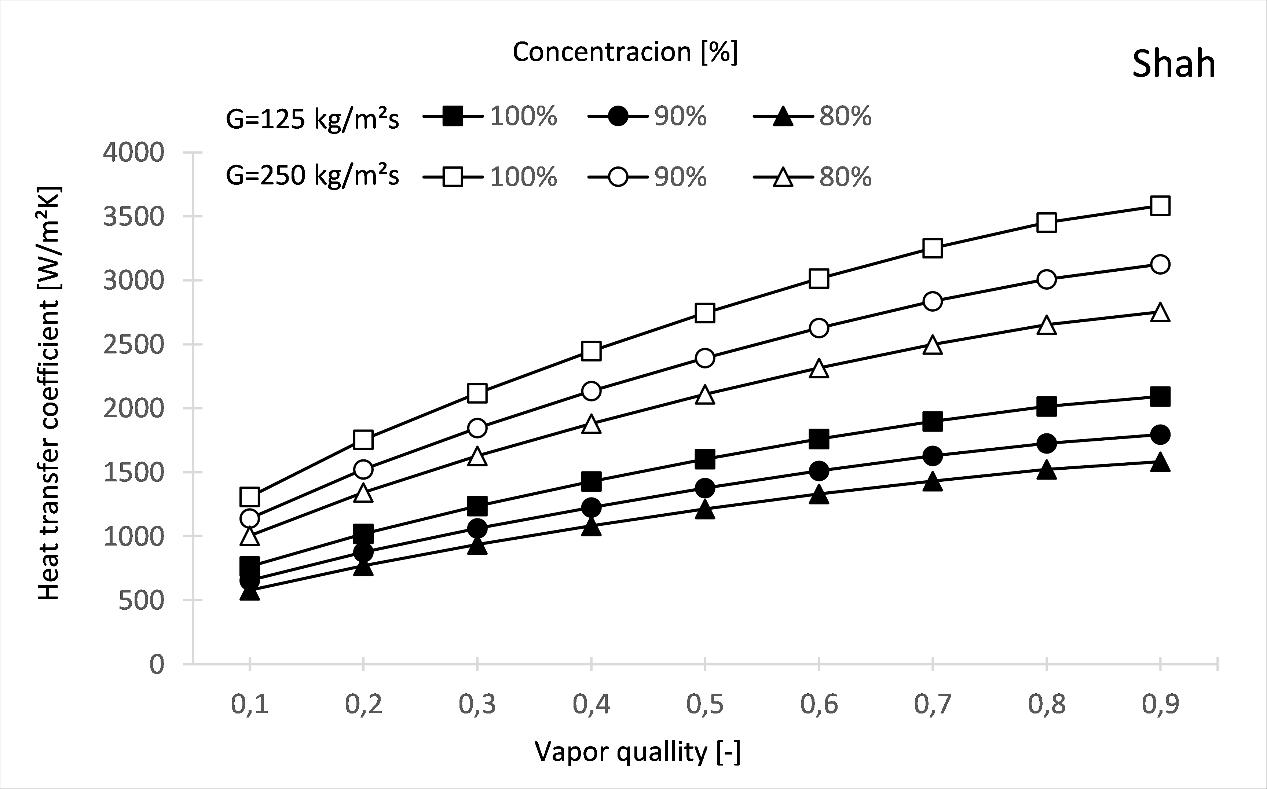
Figure 9: Heat transfer coefficient based on the Shah correlation [9]
Investigation of the Thermodynamic Characteristics of the Ester Oil 23

Figure 10: Heat transfer coefficient based on the Cavallini correlation [10]
4. Conclusion
The thermodynamic properties, density, and kinematic viscosity, of the R152a, R125, R134a and R123 refrigerants and POE 68 ester oil mixture, were investigated as a function of refrigerant temperature.
It was found that the density values of the R134a/POE 68 and R123/POE 68 mixtures showed the same trend, with lower density values at 80% concentration than those of the pure refrigerant.
It must be also emphasized that for R152a/POE 68 and R125/POE 68 the density values were almost identical for 80%, 90% and 100% concentration.
For the mixtures R152a/POE 68, R125/POE 68, R134a/POE 68 and R123/POE 68, the change in kinematic viscosity values was the same as a function of temperature. Experiments highlighted that the mixture R123/POE68 had the highest density and kinematic viscosity of all investigated mixtures: 1.6 g/cc respectively 1.5 CSt. Furthermore, it was determined that with the increase of concentration, all four mixtures presented a strong increasing trend of the kinematic viscosity.
Besides this, it must be highlighted that the density values of all mixtures were significantly lower than the density of the pure refrigerant.
In conclusion, increasing the proportion of ester oil in the mixture concentration had a negative effect on the amount of heat transferred during
24 R. Santa
convective heat flow and also on the heat transfer coefficient Eq. (2). Fig. 9 and Fig. 10 showed the effect of the mixture of refrigerant and oil on the values of the heat transfer coefficient as a function of vapor quality and heat mass flux. Two condensation heat transfer models were investigated, namely the Shah and Cavallini correlations. In both cases, it can be seen that as the proportion of oil increases, the values of the heat transfer coefficient decrease.
References
[1] Santa, R.,
“Comparative Analysis of Heat Pump System with IHX Using R1234yf and R134a” , Periodica Polytechnica Mech. Eng., vol. 65, pp. 111, 2021. [2] Kassai, M., “Investigation of the thermal behavior and energy consumption of refrigeration systems” , Thermal Science, vol. 25, no. 1 Part A, pp. 73–83, 2021. [3] Sánta, R., Garbai, L., Fürstner, I., “Optimization of heat pump system” , Energy, vol. 89 pp. 45–54, 2015. [4] Sánta, R., Garbai, L., Fürstner, I., “Numerical investigation of the heat pump system” , J. Thermal Cal., vol. 130, no. 2, pp. 1133–1144, 2017. [5] Santa, R., “The Analysis of Two-phase Condensation Heat Transfer Models Based on the Comparison of Boundary Condition” , Acta Poly. Hun., vol.9, no. 6, pp. 167–180, 2012. [6] Santa, R., Garbai, L., “Measurement testing of heat transfer coefficients in the evaporator and condenser of heat pumps” , J. Thermal Cal., vol. 119, no. 3, pp. 2099–2106, 2015. [7] Garbai, L., “Csőhálózatok hidraulikája: Állandósult áramlás”, Akadémiai Kiadó, Budapest, 2018 [8] Thomas, J., Bruno, T.J., Fortin, M. L., Huber, A.L., Eric W. L., Elisabeth M., Mark O. M., Stephanie L. O., Richard A. P., Kimberly, N. U., Jason A. W., “Thermophysical Properties of Polyol Ester Lubricants” , NIST Director and Undersecretary of Commerce for Standards and Technology, 2019. [9] Shah, M. M., “A General Correlation for Heat Transfer during Film Condensation inside Pipes” , International Journal of Heat and Mass Transfer 22, no.4, pp: 547–56, 1979. [10] Cavallini, A., and R. Zecchin, “A dimensionless correlation for heat transfer in forced convection condensation” , in Proceedings of the Fifth International Heat Transfer Conference, Tokyo, 1974, pp. 309–313.








